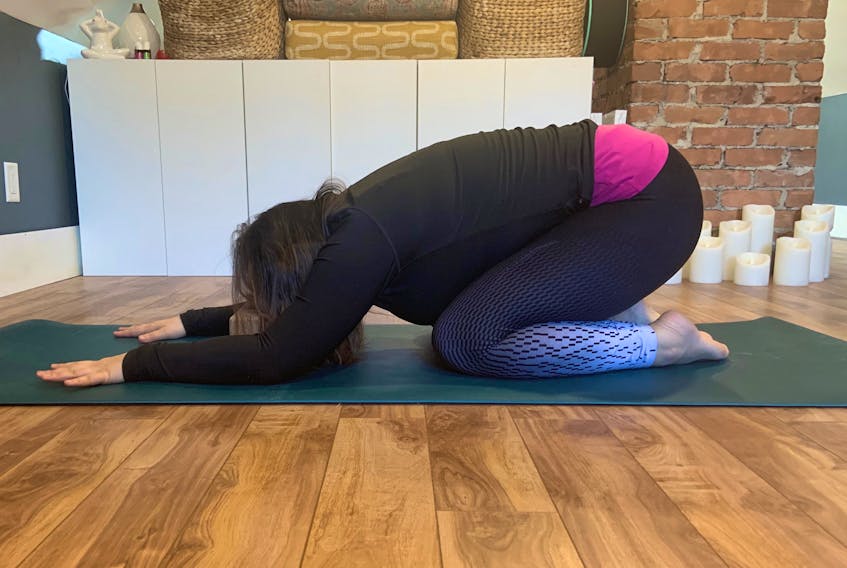By Nancy Buckle
Hello everyone! I am a yoga teacher and yoga studio owner. Yoga came into my life 23 years ago and I fell in love with the way it made me feel in my body, mind, and spirit. It has been a lifelong journey ever since.
Because of what I do for a living, I spend a lot of time educating people about what exactly yoga is. So often in our western world, when you ask someone the question, “What is yoga?” you will receive a response that includes: stretching, poses, exercise, and calming techniques. They may talk about images they have seen on Instagram of extremely fit and flexible people striking a yoga pose on the top of a mountain or some other magical landscape. Well, yoga is those things, that is true. AND it is actually so much more than any of those things.
Have you ever felt too intimidated to try a yoga class? You may have thought you are not flexible or fit enough or that you have to lose a few pounds first. Perhaps you thought everyone else in the class will know more than you do. Many people tell me they are afraid to look out of place or worry that people will judge them for being there.
If you have felt any of these things before, you are definitely not alone. These are conversations I have almost every day of my life. Yoga, as it is often presented in North America, can be pretty darn intimidating.

In this weekly article my aim is to make yoga accessible and welcoming. I will do my best to demystify it. Drawing on yoga philosophy and techniques, I will offer you options for self-compassion, self-care, and self-love. I will teach you about breathing, poses/postures, meditation, and yoga philosophy, relating it to your daily struggles and challenges. Try it. See how it feels. You can take what you like, use it in your life, and leave what doesn’t work for you. We will work together on one topic per week. I will discuss it and offer a yoga practice for you to try.
Today we will get started with self-compassion! This is a biggie. It sounds simple. Treat yourself with the same kindness and care you would give to a friend when you find them struggling. Yet self-compassion is a very challenging practice for most of us. For some reason, the voice of our inner critic can drown out that soft, loving voice of compassion.
Would you like to learn how to be more compassionate towards yourself? I am guessing your answer is yes. So, let’s start at the beginning and dive into what self-compassion is and explore how we can cultivate it.
What is compassion? The Yoga Sutras (1.33) say that compassion is a shared feeling, a level of sympathy so deep that it inspires action to alleviate another’s pain or sorrow. It also states that practicing compassion is a way to purify our minds and increase our experience of serenity.

Dr. Kristin Neff, a pioneer in the field of self-compassion research, says that the following four things happen when we show compassion for others:
1. We notice when someone is suffering;
2. We feel so moved by others experience that our heart responds to their pain;
3. We offer understanding and kindness to others when they fail or make mistakes, rather than judging them harshly; and
4. We realize that suffering, failure, and imperfection is part of the shared human experience.
I am sure you can recall having experienced compassion for another person, and perhaps a time when compassion was extended to us from another person. Spend a few moments thinking about those experiences. Times when you have moved through those four steps to show compassion to someone, and times when someone else did it for you. We can use this as the basis for cultivating self-compassion because these experiences show us that it feels good to be shown compassion. It helps a person move through the pain and suffering in the moment.
When it comes to our own experiences, many of us find it easier to fall into patterns of negative self-talk, or we develop a “stiff upper lip” mentality, where we judge ourselves harshly and don’t leave room for failure or imperfections. These patterns are not healthy or productive and can contribute to stress, frustration, and a poor sense of self. It is necessary, as humans, that we understand things won’t always go the way we planned, that we have room to make mistakes, and that we may fail, mess up, or not measure up. It is OK to be less than perfect. Having these experiences is OK. When we take a compassionate stance, we give ourselves room to be human.
Making changes in our thought and behaviour patterns are not as easy as just reading an article that tells you to shift your mindset! It involves practice. Today, I am offering your three short practices (a breathing exercise, a series of four yoga poses, and a meditation practice), that you can use to cultivate self-compassion. The next time you notice you are suffering, being hard on yourself, or not meeting expectations, try one or a combination of all of these.
Nancy Buckle (MEd. E-RYT) is a yoga teacher, educator, and trainer. She holds a master’s degree in education in counselling psychology and has worked in the health and wellness field for almost 20 years. Learn more about her business, Namaste Yoga Studio in Corner Brook, NL, and the online classes currently available, at www.namastestudios.ca/membershipsandclasses If you have any topic requests or feedback you can send them to i[email protected]









